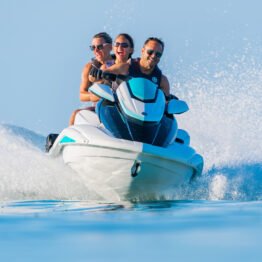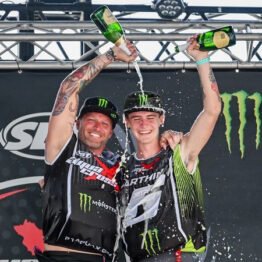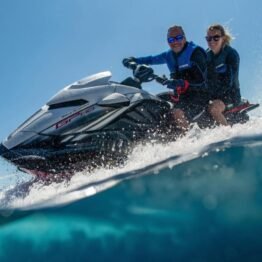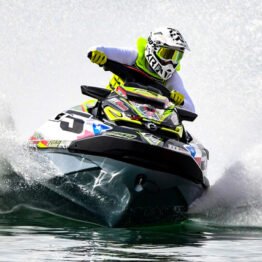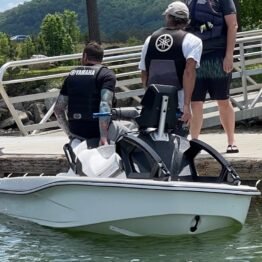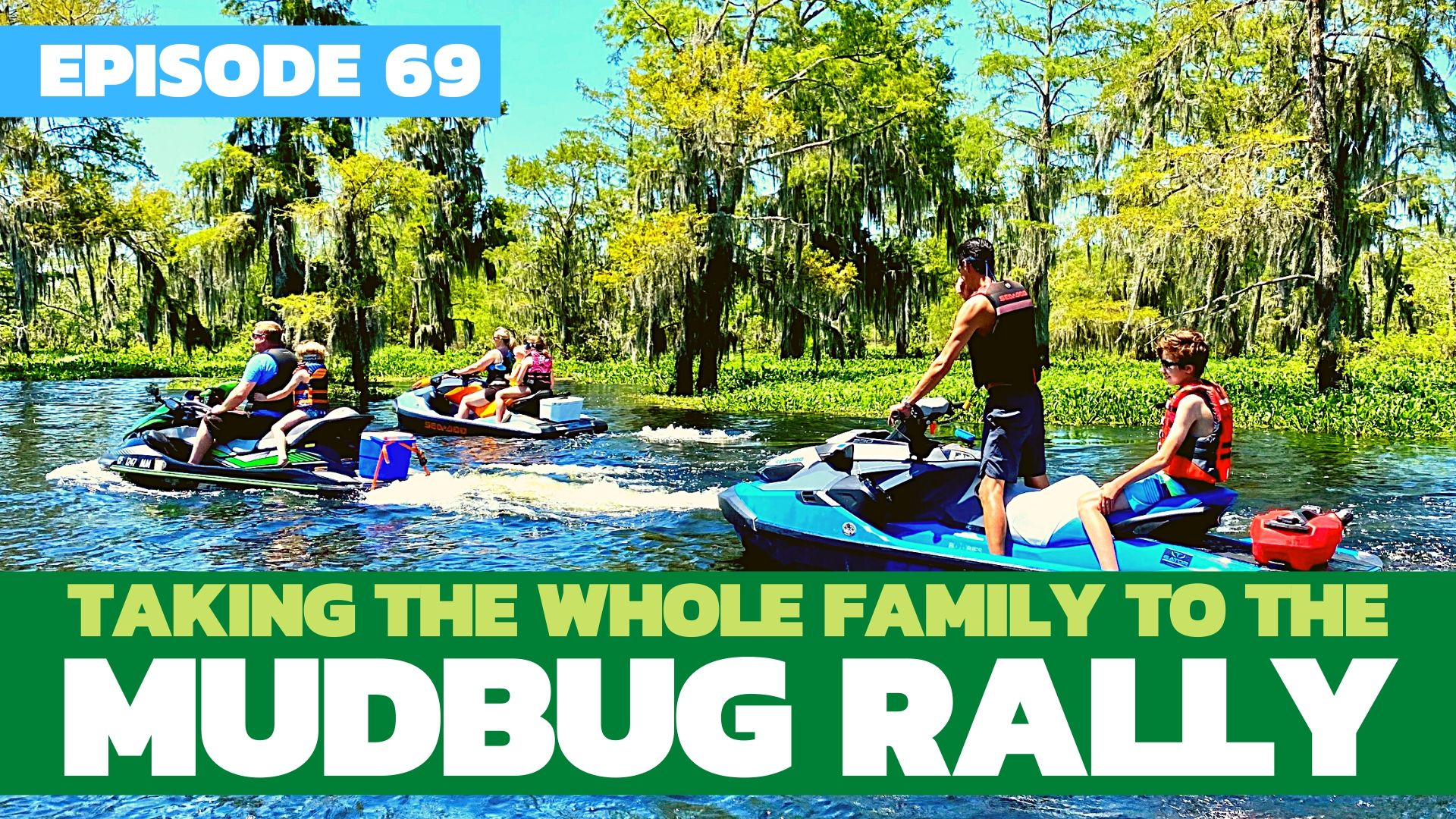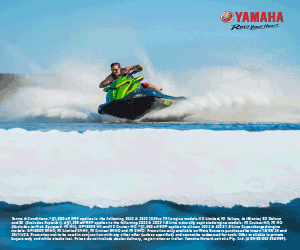
Several day’s worth of heavy rain threatened to cancel the 14th annual Mudbug PWC Rally in Morgan City, Louisiana. The downpour had flooded Lake Palourde and the canals surrounding Avoca Island, raising the waterline to dangerous levels. With threats of local police enforcing No Wake Zones through most of the area, many feared that this year’s event wasn’t going to happen. Thankfully, with just a few days left to the June 12th weekend, water levels began to recede as quickly as they rose, and any threat to the high-banked levees were removed. Mudbug was a “GO” and The Watercraft Journal would be arriving in top form.
This year would mark my 6th time attending the event, one which I shared exclusively with my oldest daughter up until this point. In light of the fact that the school year was prematurely ended, and that my other two children were finally old enough to enjoy rides on the water, it was decided that the whole family would join the fun. Thankfully, strong gusts from the Gulf had blown in, clarifying the water and dropping the normally brutal humidity to a very palatable percentile. In fact, our four days in Morgan City were some of the most pleasant to date – with temperatures in the low-to-mid 80s and clear blue skies.
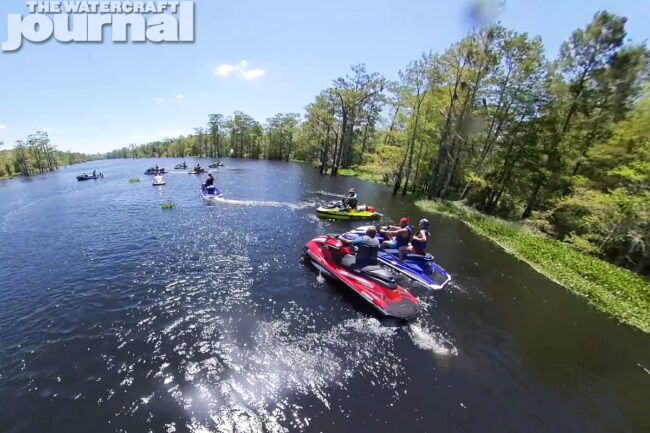
Unlike previous years where the world’s fastest personal watercraft sought to size-off against each other in heads up drag racing and then precision radar runs, recent Mudbug Rallys have focused more on the group rides and winding scenery. Perusing the official event thread on Greenhulk.net teased several potential rides to join; the forum acting as the central hub for those visiting the gulf coastal meet. Although our estimated time of arrival would set us in town by mid-afternoon on Thursday, many adventure-seekers were on-site a day or two earlier, careening the trails that branched from the Atchafalaya River.
Wanting to keep kids and wife comfortable over two days of riding also meant carefully picking which watercraft to bring. For this trip, the trailer was loaded with two units completely redesigned for the model year; The Watercraft Journal‘s long-term loaner, a 2020 Sea-Doo GTI SE 170 in Ice Metal and Orange Crush; and a 2020 Kawasaki STX 160LX JetSki in Ebony and Candy Lime Green. Both units represented each brand’s highest-level entry in the Recreation segment of watercraft – the group most targeted towards family-friendly budgets.
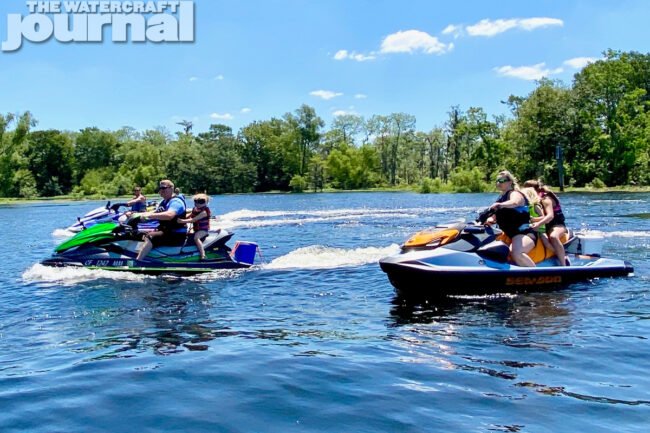
Equally, both machines were equipped from the factory with each brand’s respective on-board sound system – Jetsounds for the Kawasaki and Sea-Doo’s BRP Premium Audio Package on the GTI. Curiously, we discovered early on that the Kawasaki’s Jetsounds system offers no “off” button [correction: the power button’s there, just tucked up high, underneath the handlebar pad – Ed.] and will automatically begin playing music synced through your Bluetooth-connected smart phone whether you want it to or not. So just be mindful of that.
Additional standard features found on both machines include Cruise Control and watertight storage cubbies for cell phones found in the glove box. As equipped, our Sea-Doo would fetch $12,199 on the showroom floor, while the Kawasaki would come in $500 less at $11,699. Of course, it’s important to note that the STX 160LX is lacking a functioning brake system – employing a left-hand reverse lever – versus the Sea-Doo’s Intelligent Brake & Reverse system.
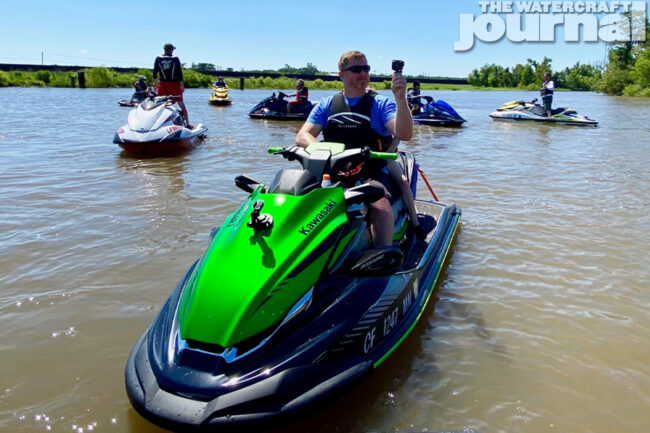
Waking up to crystal blue skies, we journeyed up the isthmus between Flat Lake and Lake Palourde, to the gathering spot at Doiron’s Landing just over the levee. The Sea-Doo was fitted with the 4.5-gallon LinQ accessory cooler, as a small Igloo cooler was ratchet-strapped to the narrow swim platform on the Kawasaki – both packed with cold drinks and snacks for the day’s ride.
For our Friday excursion, we joined longtime Mudbug veteran and friend Billy Duplessis for a modified “Flat Lake Loop.” Lead by Louisiana native David Fountain, the path provided a wonderful variety of wide open channels, mirror-smooth water and plenty of twisting, narrow trails passing beneath the shade of overhanging cypress trees dripping with Spanish moss.
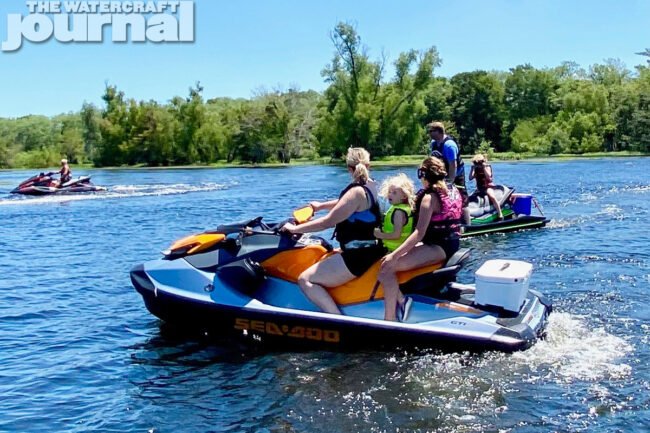
My wife and two daughters rode effortlessly aboard the Sea-Doo, it’s two-tier Ergolock seat comfortable for the three of them. From above, the GTI’s redesigned bench is somewhat Coke-bottle shaped, with pinches in the middle for rear passengers to sit more comfortably. Equipped with the newly re-engineered, naturally-aspirated 1630 ACE, our GTI fared well in regards to fuel mileage (averaging a little over 5 miles per gallon) but its limited 15.8-gallon fuel cell drained quickly, causing us to pack it in a little early. Conversely, our STX 160LX barely made a dent in its gargantuan 20-and-a-half gallon tank, tempting us to leave the rest of our party behind.
Nevertheless, the two units were loaded back up onto the trailer while the family cooled off inside of the car, it’s air conditioning blasting frigid air from all vents. It wasn’t until well past 6pm that evening that the rest of Duplessis’ party made it back to the launch ramp. The next morning promised a slightly more calm adventure, albeit a familiar one. PWCTrailfinder.com‘s own Billy Crews promised to take us for a personal tour of Bayou Cocodrie and Bayou Chevreuil, both just north of the previous day’s ride.

Joined by Wade Robinson and Becky Brown aboard his naturally-aspirated Ultra LX JetSki [correction, a naturally-aspirated Honda F-15 Aquatrax – Ed.], our four watercraft sped up the canal and into the marsh. Above Bayou Gunnie are a series of perpendicular lanes cut into the treeline. These man-made channels were cleared by oil companies, who pump out several thousand gallons of crude a week. While the pipelines rested well below the hulls of our watercraft, the ever-present signs and markers were constant reminders.
At one point, Billy stopped and noted at the remoteness of the swamp recalling a family friend who had become stuck on a shallow sand bar while venturing into the bayou for some quiet fishing had to wait overnight for the tide to come in. Traffic was so irregular that nobody had come by during the 12 hours that he was stuck – a fate we did not want to share.

Racking up several hours’ worth of ride time over two days aboard the redesigned STX revealed some quirks that hadn’t appeared during my initial introduction earlier this year. Although the 2020 redesign radically improves upon the deck of the outgoing STX, the hull itself remains unchanged. In doing so, the overall height of the STX was raised over 4-inches (from 41.3 to 45.4-inches), which is substantial.
This added height changes the Kawasaki’s center of gravity. I soon discovered that at speeds between 30-to-45mph, the STX will teeter on its keel from left to right; only when really ripping at top speed (a GPS-confirmed 58mph) does the Kawasaki feel fully planted and secure. Equally, when riding as a passenger, the rearward weight distribution causes the STX 160LX to porpoise, bobbing its nose up and down – even when skirting across mirror-flat water. The Sea-Doo has also done this at times, but toggling its standardized VTS electric trim quickly resolves it.
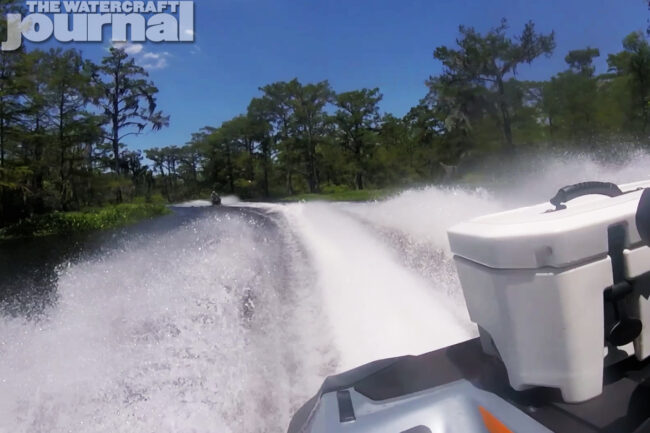
Concluding Saturday’s ride, the two skis were loaded up on the trailer and dropped off with Greenhulk‘s own Jerry Gaddis for safe keeping. The next morning, we drove an hour back east to New Orleans for a day in the French Quarter. Founded in 1718 by Jean-Baptiste Le Moyne, New Orleans’ French Quarter remains one of the continent’s oldest surviving settlements and has remained the nation’s most contested piece of territory – playing key roles in the Seven Years’ War between the French and Spanish; the American Revolution, the Battle of 1812 and of course, the American Civil War.
Lining the banks of the Mississippi River and facing Algiers Point, New Orleans’ French Quarter is one of the nation’s most treasured locations. Upon our arrival, we quickly joined the line for a bag of piping hot beignets from Cafe Du Monde, the renowned open-air coffee shop located on Decatur Street first opened in 1862. After loading up on these traditional French doughnuts doused in layers of powdered sugar, we decided to walk off the sugar rush by touring Decatur Street down to the Place de France displaying its gilded statue of Joan of Arc.
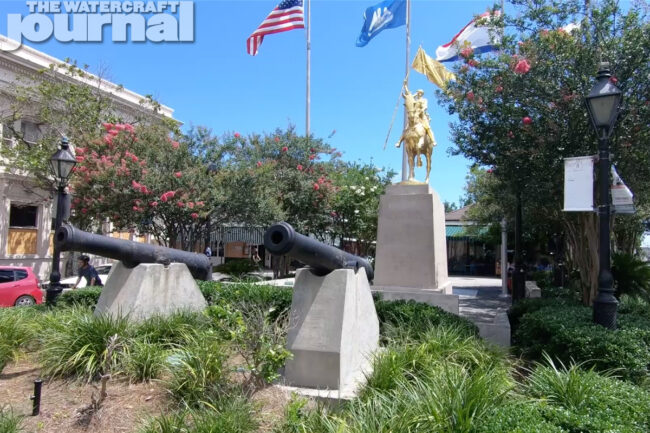
Doubling back towards Jackson Square, we passed by confectioneries selling candied pralines, restaurants preparing slow-cooked gumbo, and even a store arranging for jazz funeral marches. Prior to becoming the gated city park it is today, Jackson Square was once a military parade ground as well as the site for public executions. Even under the shadow of the peaked St. Louis Cathedral, the severed heads of convicted criminals and escaped slaves once hung on display (yikes!).
Next door to the whitewashed walls of the basilica is the Cabildo, the once Spanish colonial city hall. Today the edifice stands as the Louisiana State Museum and location where the final transfer papers for the Louisiana Purchase were signed. As we walked the cobblestone streets, ornate wrought iron balconies and galleries hung above our heads. Decorated with multi-colored strands of beads, flags and Mardi Gras novelties, the entirety of our circuit up and down Royal and Bourbon Streets was a sight to behold – even on a quiet Sunday morning.
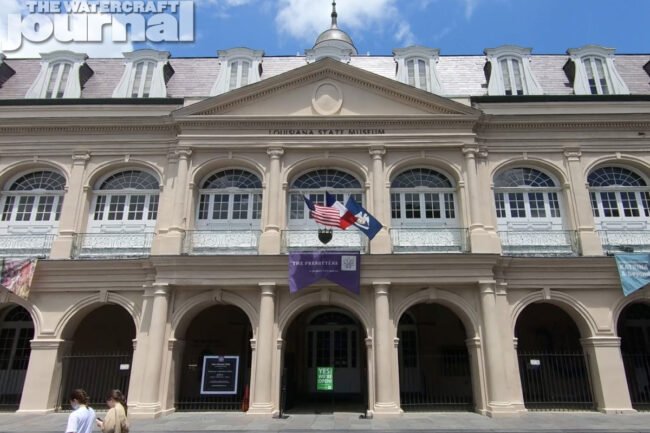
Signs advertising ghost tours, voodoo rituals and even a haunted apartment for rent caught my eye. Landmarks like the historical New Orleans Pharmacy & Apothecary, Hotel St. Helene, and even the former home of playwright Tennessee Williams beckoned to my inner history-lover. Instead, we loaded up the family and do some first-hand ghost hunting ourselves at the famed above-ground tombs of the St. Louis Cemetery number 2.
Infamously known as New Orleans’ second Necropolis or “City of The Dead,” the second cemetery was open to the public while the older first above-ground cemetery was closed for renovations. Here early 19th century city planners began relocating their dead in order to stave off the spread of cholera. Here lies the remains of several noteworthy New Orleans Jazz musicians as well as famed French privateer Dominique You who joined General Jackson in his defense against the impending British invasion.
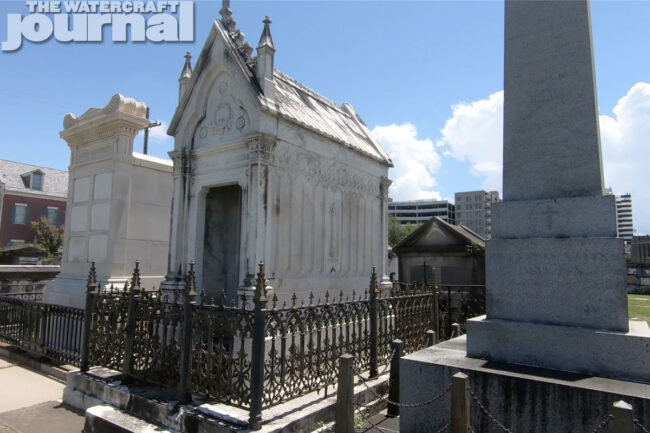
Seeking relief from the delta sun, we hurried over to Sal’s Sno-Ball Stand. A local favorite since 1960, Sal’s has been serving up dozens of different flavors of icy treats – and came to me as a “must go to” stop by Wade Robinson before leaving for home the next day. Doused in a multitude of colorful sugary syrups, we each enjoyed our sno-ball before heading back to Morgan City. That evening we hitched up the trailer yet again, stopped to take the obligatory photograph in front of the Morgan City sign, and readied for the long drive back to Tennessee.
The Mudbug PWC Rally might’ve changed over the years, but the quality of memories made here are no less valuable. Friendships are made and rekindled here. Newfound experiences and stories that can be shared for years always happen at the Mudbug and it’s an annual tradition I strive to never miss.
Additional photography provided by Billy Duplessis.


